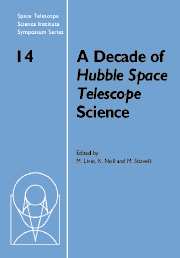Book contents
- Frontmatter
- Contents
- Participants
- Preface
- HST studies of Mars
- HST images of Jupiter's UV aurora
- Star formation
- SN1987A: The birth of a supernova remnant
- Globular clusters: The view from HST
- Ultraviolet absorption line studies of the Galactic interstellar medium with the Goddard High Resolution Spectrograph
- HST's view of the center of the Milky Way galaxy
- Stellar populations in dwarf galaxies: A review of the contribution of HST to our understanding of the nearby universe
- The formation of star clusters
- Starburst galaxies observed with the Hubble Space Telescope
- Supermassive black holes
- The HST Key Project to measure the Hubble Constant
- H0 from Type Ia supernovae
- Strong gravitational lensing: Cosmology from angles and redshifts
Star formation
Published online by Cambridge University Press: 13 August 2009
- Frontmatter
- Contents
- Participants
- Preface
- HST studies of Mars
- HST images of Jupiter's UV aurora
- Star formation
- SN1987A: The birth of a supernova remnant
- Globular clusters: The view from HST
- Ultraviolet absorption line studies of the Galactic interstellar medium with the Goddard High Resolution Spectrograph
- HST's view of the center of the Milky Way galaxy
- Stellar populations in dwarf galaxies: A review of the contribution of HST to our understanding of the nearby universe
- The formation of star clusters
- Starburst galaxies observed with the Hubble Space Telescope
- Supermassive black holes
- The HST Key Project to measure the Hubble Constant
- H0 from Type Ia supernovae
- Strong gravitational lensing: Cosmology from angles and redshifts
Summary
The angular resolution of HST has provided stunning images of star forming regions, circumstellar disks, protostellar jets, and outflows from young stars. HST has resolved the cooling layers behind shocks, and enabled the determination of outflow proper motions on time scales less than the post-shock coolingtime. Observations of the best studied region of star formation, the Orion Nebula, has produced many surprises. HST's superior resolution led to the identification of many new outflow systems based on their proper motions, the discovery of dozens of microjets from young stars, and the detection of wide-angle wind-wind collision fronts. HST has also produced spectacular images of circumstellar disks which have led to a rethinking of some aspects of planet formation. It now appears that most stars in the sky are born in environments similar to the Orion Nebula where within a few hundred thousand years after their formation, proto-planetary disks are subjected to the intense radiation fields of nearby massive stars. As a result, Orion's disks are rapidly evaporating. But at the same time their dust grains appear to be growing. Multi-wavelength images indicate that most of the solid mass in these disks may already be in large grains, possibly larger than a millimeter in size. The formation frequency of planets and the architectures of planetary systems will be determined by the competition between grain growth and photo-evaporation.
- Type
- Chapter
- Information
- A Decade of Hubble Space Telescope Science , pp. 44 - 63Publisher: Cambridge University PressPrint publication year: 2003



